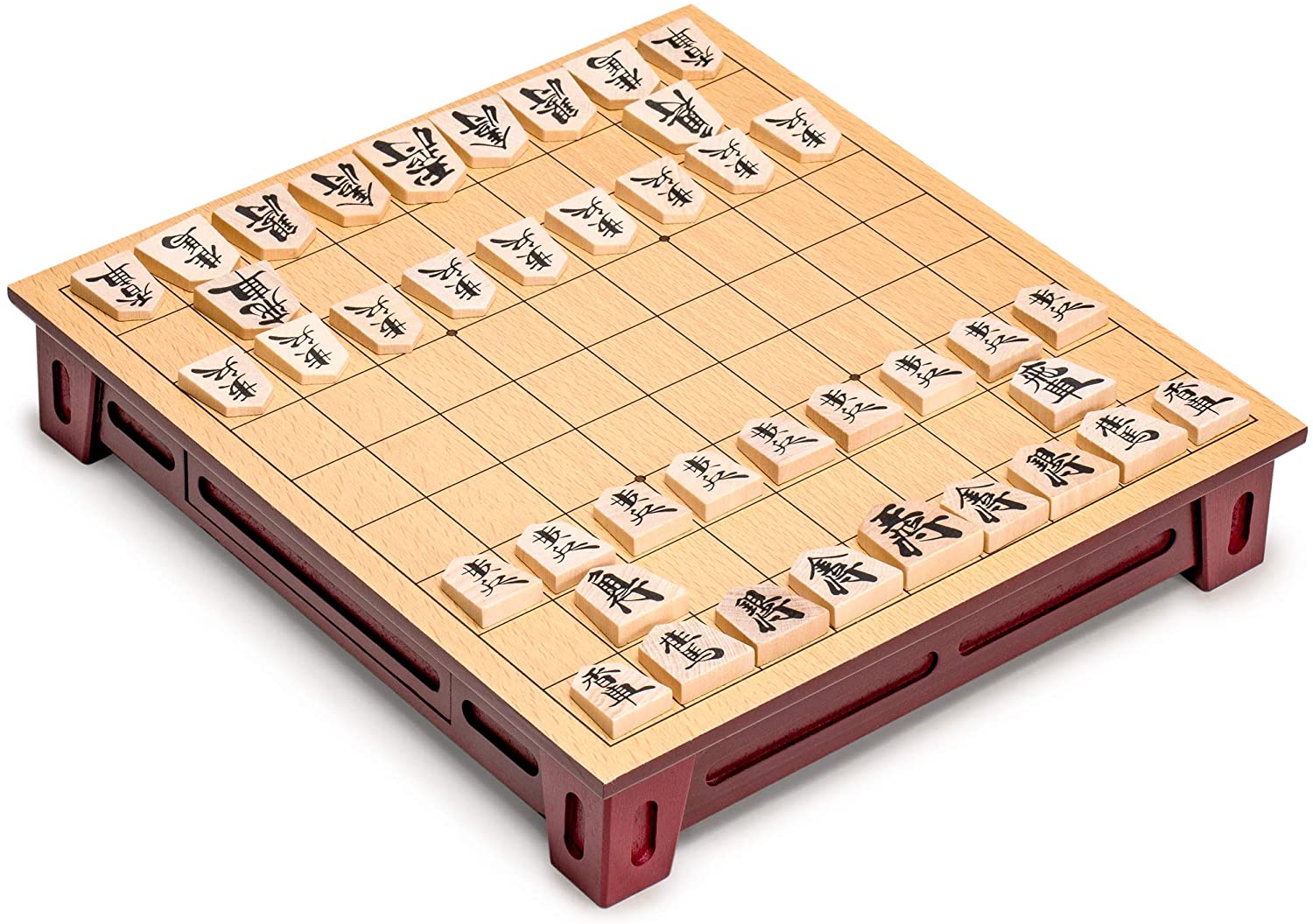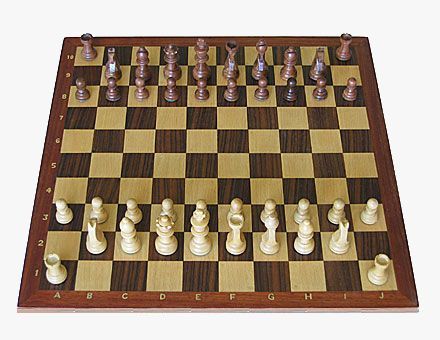Chess is fairly well known, but there's also an entire world of chess variants, games that take the core ideas of chess and change either a few details or completely reimagine the game, either to improve the game, or just change the flavour of the game. There's even an entire website dedicated to documenting different variants of chess.
Today I want to tell you about some classic chess variants: Crazyhouse chess, Grand chess, and Shogi (Japanese chess), and posit a combination of the first two that I suspect may become my favorite chess when I have a chance to try it.
I.
Shogi is the version of chess that is native to Japan, and it is wildly different from western chess - both western chess and shogi have evolved continuously from the original chaturanga as the game spread out from India. The core difference between shogi and the familiar western chess is that once a piece has been captured, the capturing player may later place the piece back on the board as his own piece. But if that was the only difference, it would make for a very crazy game, since the pieces in western chess are so powerful while the king is so weak, that the game would be filled with precarious situations that would require the players to always have their guard up for an unexpected piece drop, and checkmate is never more than a few moves away unless both players are paying close attention.
In fact, this version is precisely crazyhouse chess, and this property is both what makes crazyhouse chess so beloved and fun, but also what stands in its way of being taken as seriously as orthodox chess. There are two ways that this barrier could be overcome - either the king can be buffed, giving him more mobility to better dodge the insanity that the drops create, or the pieces can be nerfed, making them much less powerful, and particularly to have less influence at a long range. Shogi chooses the route of nerfing the pieces, replacing the long-ranged and very influential pieces used in orthodox chess with a set of pieces that have much more limited mobility, such as the lance, which moves like a rook, but can only move straight forward (thereby limiting its position to a single track), the uma (horse), which moves like a knight, but can only move in the two forwards most positions, or the gold and silver generals, who can only move in a subset of the directions that a king can move in. Since each piece isn't much stronger than a king, it is much easier for the king to dodge the threats produced by each piece, and a king can only be checkmated when the pieces are acting in coordination to create a trap for the king. (This is the basis of tsume-shogi, checkmate puzzles for shogi. They are fun to solve, and I recommend trying them out to get a feel for how different checkmates in shogi are from orthodox chess checkmates)
I think shogi and crazyhouse solve a problem that I have with modern orthodox chess: the game ends in draws far too often, and the endgame is just too sparse for my taste. You can get good puzzles out of orthodox endgames, but I find the endgames of shogi and crazyhouse to be much more fun and much more exciting.
I a. (An aside)
While I'm on the topic of shogi and crazyhouse, shogi pieces look quite different from the pieces used in orthodox chess:

I quite like the look of these pieces, and it provides a solution to a practical problem that arises from the piece drop mechanic: With orthodox chess pieces, one would need two sets of chess pieces, a double-sized army for each player, since each player may have up to twice the regular amount of each type of piece after they capture the enemy’s pieces. With these flat, wedge shaped pieces, though, a player can just make the piece face in the opposite direction towards their opponent, and a single set of pieces is enough to play the game. While I think this solution works, and these pieces are quite iconic for shogi, it just doesn’t feel right to play crazyhouse chess with pieces like this: crazyhouse chess is orthodox chess at its core, and it feels right to play crazyhouse with orthodox chess pieces. My ideal solution would be pieces that are as tall as orthodox chess pieces, and have a similar design language, but which are anti-symmetric: the pieces would have flat tops and bottoms, and can be flipped upside down to change the colour of the piece, since one end would be white, and the other end would be black. I imagine the two colours would meet in the middle, with a diagonal slant so that it would show one colour primarily to one player, and the other colour to the other.
II
It's been an observation made more than once, that there's a certain feeling of completeness to the orthodox chess pieces: The rook and bishop each move straight in certain directions, either perpendicularly / parallel to the line of battle, or diagonally to the line of battle. If you were to draw a 5x5 square around each piece, the knight can move to precisely the squares that a rook and bishop can't go to. And the queen can be viewed as the sum of a rook and a bishop. It all feels very interconnected, and almost perfectly complete and platonic. Almost perfectly, because there's two sums that we don't have in orthodox chess: the combination of a rook + knight, and a bishop + knight. These pieces, called the marshal and cardinal are quite fun pieces to play with, and I would not argue that chess is a better game for omitting these pieces. As such, there have been proposals to add these pieces to the game, the most well-known of which are Capablanca chess and grand chess, proposed by Chess World Champion J. R. Capablanca and the game designer Christian Freeling, respectively. The main difference between the two is that Capablanca chess is played on a board 10 wide by 8 tall, while grand chess is played on a 10x10 board, with an empty file behind each player's pieces, aside from the rooks, which are placed in the very back corners (what about castling? Simple, you can't castle in grand chess):

The additional width of the board in Capablanca and grand chess is used to allow one each of the marshal and cardinal to be placed in each player's army. Aside from the additional pieces and larger board, grand chess plays just like regular chess, but I think it deserves to be considered seriously as an alternative to the traditional rules for chess.
III.
While an introduction to chess variants would make a good topic for a post here, that's not what I'm writing right now. While these three games would certainly be present in such an article, the selection would be far too limited, and far too conservative - there's some really crazy, wacky, fun, and brilliant ideas in the world of chess variants which I won't be touching on today. I'm writing today because I want to talk about what I think may be the best contender as a replacement for orthodox chess, a cross between grand chess and crazyhouse, with a slight modification to better handle the drop mechanic of crazyhouse. It's clear that Capablanca chess and grand chess were intended from the very start as rivals to the standard ruleset, and I mentioned previously that shogi solves a problem that I have with orthodox chess: orthodox ends in too many draws, and I find orthodox endgames to be less exciting than crazyhouse and shogi endgames. My ideal game of chess would look more like crazyhouse than orthodox chess, since drops just make chess more fun. As I mentioned before, while crazyhouse is a fun game, it's just too intense and unpredictable to present a serious challenge to orthodox chess (at least, that is what I suspected as I was thinking about this post). There are two ways this can be addressed: the first is to do as shogi did, and make the pieces almost all as weak as the king, so the king can more easily survive against the enemy pieces; but doing this makes the game a different game from orthodox chess; it's no longer just a variant on orthodox chess, it's a completely different flavour. A flavour that I happen to love, but not the flavour of orthodox chess. I wanted a game that would preserve the heart of orthodox chess, while giving it the dynamic aspect allowed by drops, but more balanced and sane than crazyhouse chess.
So let's explore the second way to balance crazyhouse chess: instead of nerfing the pieces, let's make the king more formidable, more nimble, and able to more easily survive the intensity of drop chess. I haven't playtested this yet, but it seems appropriate to give the king the 4 backwards moves of the knight: This will give mobility to the king, without giving it too much mobility, and limiting the king to the backwards moves will ensure that it remains a defensive piece, and doesn't gain a new life as an aggressive part of the attacking force. Playtesting may prove this to be too weak (I don't anticipate that it will make it too strong): If this is the case, a different profile of movement may make sense for the king, but in any case, it is clear that increasing the mobility of the king will allow for a balanced form of drop chess.
Ideal Chess
So my ideal chess would differ from orthodox in the following ways:
- The game is played on a 10x10 board, instead of the traditional 8x8 board (I feel that a wider board will make for a more fun, and deeper, game of chess)
- The game will feature the marshall (rook + knight) and cardinal (bishop + knight) of grand chess, and will have the pieces arranged in the same way as grand chess (this also implies no castling)
- When a piece is captured, it may be dropped back in to the game by the capturing player (working exactly as in crazyhouse chess or shogi)
- The king may, in addition to its usual move, move using one of the 4 backwards moves of the knight. Pieces may be captured using this backwards move.
Ideally, the game would be played using the tall, bichromatic, antisymmetric pieces I propose in section I a of this post.
from Hacker News https://ift.tt/37urTu9
No comments:
Post a Comment
Note: Only a member of this blog may post a comment.